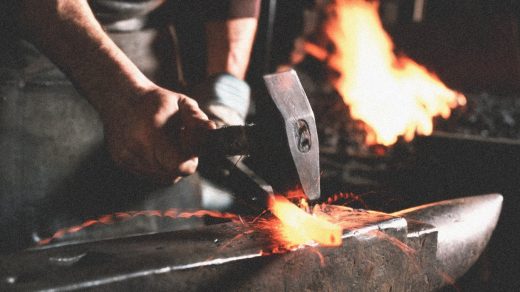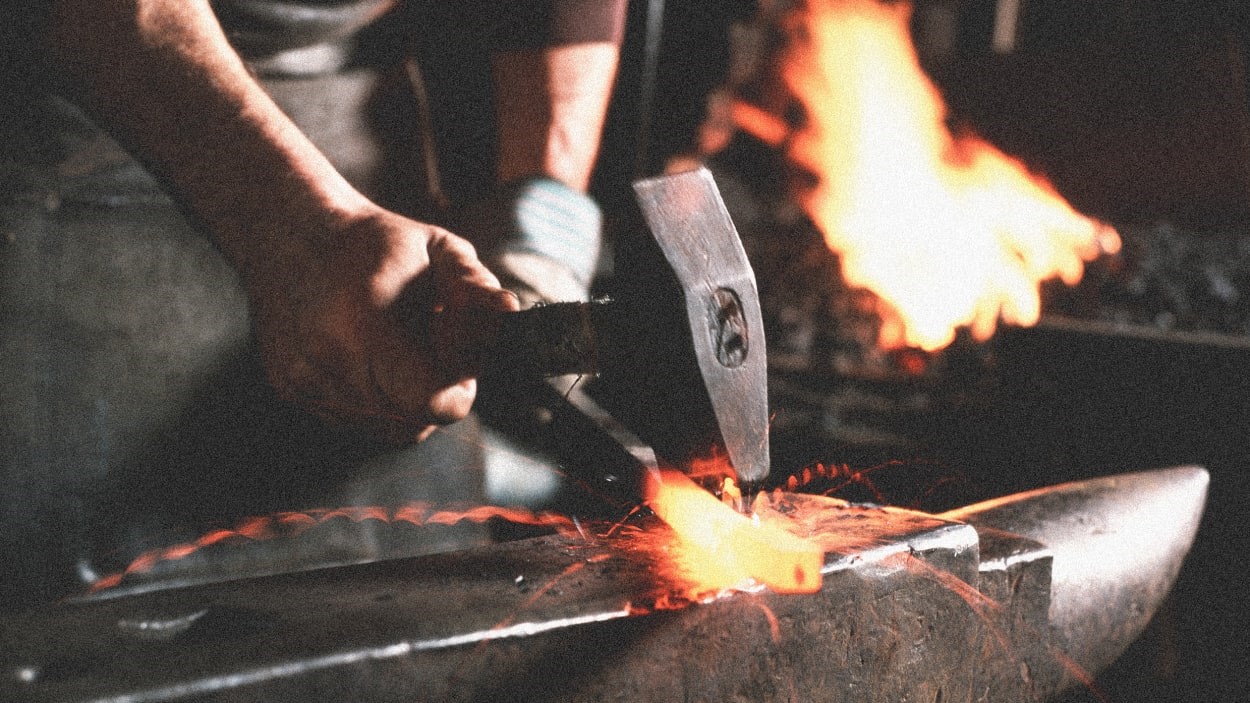How a modern blacksmith built a thriving business by leaning into handmade work
Even though the trade was in his blood, Nicholas Moreau didn’t set out to become a blacksmith. He had his sights set on a career as an economist. After graduating from McGill, he was earning a master’s degree in ecological economics at Edinburgh, but decided he also wanted to immerse himself in a trade. So, he sought out a master blacksmith, Jim Whitson, at The Blazing Blacksmith, signed on as an apprentice, and proceeded to fall in love with the work.
After earning his degree and returning to the States, Moreau built a client base at weekend arts fairs before leaving his full-time job as a conservation economist to make blacksmithing his primary career in 2019. Since then, he has grown his business from $45,000 to more than half a million dollars in annual revenue.
But increasing sales by a factor of 10 also means 10 times the number of pieces of raw metal to fire, shape, and join into self-designed products, laboring with his young team in a workshop that adheres to the quality-over-quantity values of artisan craftsmanship.
“Because our products remain handmade, there is not the same room for exponential growth that other types of business might be able to reach for,” he says. “One of the core challenges of running an artistic business is balancing the need to realize the artisan’s vision of creativity, which is a very individual thing, with the need to produce what is wanted in the marketplace. My job as the business owner is to combine those two elements into a flourishing and sustainable operation, making sure there is enough revenue to keep the lights on, and then our drivers are more about quality of life and work experience.”
Quality versus Quantity
Bridging tradition and innovation to update the processes required to scale production, Moreau must often create the tools he needs to make the tools he sells. A Wicks Forge signature 33-inch hand-forged fireplace tongs/log grabber, for example, started out as a custom piece for one customer, but Moreau decided to make an extra set to test potential for online sales. Soon, the workshop couldn’t meet demand and had to remove the piece from the site’s sales page during the holidays.
To make the tongs more efficiently, Moreau built customized tools and jigs (which hold cutting tools in place for repetitive tasks), and the following year sold about 100 sets. “But they were still a huge pain to make, and we could never keep them in stock,” he says. After further breaking down every step of the fabrication process to create even more refined tools, 500 sets were made and sold in 2023, with much less time and effort, and without additional staffing.
“The challenge with a shop of our scale,” Moreau says, “is we are the designers as well as producers of a wide range of functional pieces. If we are going to make a spatula, we want it to be beautiful, but also function as the best spatula someone’s ever used. Craft fairs give us a chance during product development to try lots of different variations on a design; and then once it’s really locked in and we have feedback on what people like the best, we can standardize it for production and online sales.”
Online sales boomed during the pandemic. Between 2020 and 2021, Wicks Forge experienced a $200,000 spike in revenue. This wasn’t merely driven by convenience and quarantining: People felt a stronger need for connection.
Only Connect
“Beyond the product, I think people are searching for connections—both with the makers and the pieces they make, as well as the folks they share those products with as gifts or in their home,” he says. “They were looking for heirloom-quality pieces with character and a story—stories that will grow over time as they use those pieces. If you have a great story but are selling crap, I don’t think there’s much chance for long-term success. All the artwork I own, as well as the plates I use, and the cup I drink my coffee out of in the morning, have stories behind them. It could be a painting my mother’s art teacher gave her when she was in high school, or the mug my grandfather used to drink his coffee out of each morning, or a plate I traded some metalwork for with a fellow artist in Maine. When I use those pieces, I also like to remember the stories attached to them, and have those stories grow over time as I interact with those pieces over time. With that in mind, we learned to share a lot about the ideas and processes behind the products we make.”
During this period, Moreau had to make fundamental production adjustments to shift from in-person selling to a predominantly online format. At local fairs, people can pick up and feel the products to begin to form an attachment with—and each piece can be slightly different, with variations in shape, texture, or color as hallmarks of individuality. “They actually sell better that way,” he says. “But with online sales, variation is our nightmare.”
Without the high-touch element, people only have the listing photo and description to go by, so the products must look as close to the photographs as possible. “We want our products to be artistic as well as commercial, and so our biggest gains come by embracing both aspects of variation and consistency.”
Working on innovating ways to bring affordability into the handmade market, Moreau says his background in conservation and resource management informs the day-to-day production practices of the business. For instance, Wicks Forge buys steel in standard 20-foot lengths, cut down to workable 40-inch lengths to use for forging pieces. As the metal gets shorter and shorter, the shop is left with cut-offs that are anywhere from a few inches to a foot long.
“Very few blacksmith shops do the same amount of production we do, and we end up with thousands of cut-offs each year, which we save and organize by size and type,” he says. “Over the years, I’ve designed specific products, like different leaf-design clothing hooks, to utilize those cut-offs, which minimizes our generated waste, reduces our material costs, and increases our revenue. It’s a simple example but highlights the governing approach to our business.”
Descended from three generations of metalworkers, including a great-great-grandfather who worked on the Statue of Liberty, Moreau sees blacksmithing as a homecoming. After his Edinburgh apprenticeship with Jim Whitson, Moreau returned home to Connecticut and initially set up shop in his grandparent’s garage, using tools passed down for generations, including his great-grandfather’s anvil.
“I remember as a kid poking around the garage feeling like an archeologist with no idea about what I just unearthed. But now, rather than strange artifacts, the tools hold meaning and purpose.”
Collective wisdom
In 2016, he reestablished his growing business in Pownal, Maine, housed in what he calls the “Goblin Workshop”—a cobbled-together mix of old and modern tools in a 20×40-foot section of a horse barn—and acquired a small team there to learn the foundational skills needed to support modern blacksmithing as a maintainable trade.
Because he doesn’t believe anyone should work for free, Wicks Forge functions less like a conventional apprentice system and more like a craftsmanship collective, driven by Moreau’s spirit of camaraderie. “I don’t think there should be barriers to entry,” he says, “and over a dozen people have worked in my shop as part of my team with no prior experience. And I don’t look at credentials—only character. Are they going to burn the shop down? Are they going to be annoying to work with?”
Moreau would like to see blacksmithing become a relatively ordinary trade again, and designed a product line that is essentially a beginner course—tasks that help workers develop their skills while still contributing to the business.
“In fact, one of the things I’m proudest of is teaching young people foundational blacksmith knowledge which they can use here, or eventually in their own shop,” he says.
In the fall of 2023, Moreau and a friend bought a 75-acre farm in Salem, New York, where he now works and lives, sharing property space with several transported Maine employees who built tiny houses, starting with beat-up Craigslist-acquired trailers that they welded back together and then framed using lumber from trees they cut down and milled themselves.
“The houses run on solar and have water-collection systems, allowing them to live cheaply and comfortably while saving, maybe eventually moving the houses to their own land and even opening their own businesses,” he says. “As for me, relocating just gets harder. I’ve got probably 100,000 pounds of tools and equipment now, so I hope I never have to move again.”
(39)



